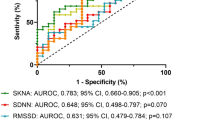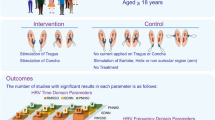Abstract
Introduction and hypothesis
Sympathetic and parasympathetic pathways of the autonomic nervous system (ANS) regulate the lower urinary tract. The aim of the present study was to synthesize the evidence regarding ANS regulation in women with urinary incontinence (UI) evaluated through heart rate variability (HRV).
Methods
This study followed the Preferred Reporting Items for Systematic Reviews and Meta-Analyses (PRISMA) guideline. Five databases were researched in April 2021 (PubMed, CINHAL, Scopus, Web of Science and Cochrane Library) and included cross-sectional studies in full-length publications in the English language. Studies assessed the HRV during bladder filling (group A) and after voiding (group B). The Joanna Briggs Institute (JBI) checklist was applied for methodological quality assessment purposes.
Results
A total of 920 articles were identified and 5 studies were included. Most studies analyzed the HRV by linear indexes. Studies from group A (n = 2) presented fair methodological quality; one study from group B (n = 3) showed fair methodological quality (Im et al. Korean J Urol. 51:183, 2010) whereas the others presented high methodological quality. One study from group A found an increase in both modulations between women with overactive bladder (OAB) versus women with stress UI, whereas a decrease was reported between incontinent and continent women. Studies from group B showed a decreased sympathetic and parasympathetic modulation in AOB with detrusor overactivity (DO), whereas one study found an increase in both modulations in women with OAB compared with stress UI.
Conclusion
Parasympathetic and sympathetic modulation increased during bladder filling and rest in UI with OAB associated or not with DO. Both modulations decreased during bladder filling in incontinent women and during rest in OAB.

Similar content being viewed by others
References
Haylen BT, de Ridder D, Freeman RM, et al. An International Urogynecological Association (IUGA)/International Continence Society (ICS) joint report on the terminology for female pelvic floor dysfunction. Int Urogynecol J. 2010;21:5–26.
Abrams P, Andersson KE, Birder L, et al. Fourth International Consultation on Incontinence Recommendations of the International Scientific Committee: evaluation and treatment of urinary incontinence, pelvic organ prolapse, and fecal incontinence. Neurourol Urodyn. 2010;29:213–40.
John G, Bardini C, Combescure C, et al. Urinary incontinence as a predictor of death: a systematic review and meta-analysis. PLoS One. 2016;11(7):e0158992. https://doi.org/10.1371/journal.pone.0158992.
Gibson W, Hunter KF, Camicioli R, et al. The association between lower urinary tract symptoms and falls: forming a theoretical model for a research agenda. Neurourol Urodyn. 2018;37:501–9.
Hubeaux K, Deffieux X, Ismael SS, et al. Autonomic nervous system activity during bladder filling assessed by heart rate variability analysis in women with idiopathic overactive bladder syndrome or stress urinary incontinence. J Urol. 2007;178:2483–7.
de Groat WC. A neurologic basis for the overactive bladder. Urology. 1997;50:36–52.
Roy HA, Green AL. The central autonomic network and regulation of bladder function. Front Neurosci. 2019;13:535. https://doi.org/10.3389/fnins.2019.00535.
Kim JC, Joo K-J, Kim JT, et al. Alteration of autonomic function in female urinary incontinence. Int Neurourol J. 2010;14:232–7.
Camm A, et al.Heart rate variability: standards of measurement, physiological interpretation, and clinical use. Task force of the European Society of Cardiology and the North American Society of Pacing and Electrophysiology. Eur Heart J. 1996;17:354–81.
Speer KE, Semple S, Naumovski N, et al. Measuring heart rate variability using commercially available devices in healthy children: a validity and reliability study. Eur J Investig Health Psychol Educ. 2020;10:390–404.
Francesco B, Maria Grazia B, Emanuele G, et al. Linear and nonlinear heart rate variability indexes in clinical practice. Comput Math Methods Med. 2012;2012:219080.
Liberati A, Altman DG, Tetzlaff J, et al. The PRISMA statement for reporting systematic reviews and meta-analyses of studies that evaluate healthcare interventions: explanation and elaboration. BMJ. 2009;339:b2700.
Higgins J, Green S. Cochrane Handbook for Systematic Reviews of Interventions. Version 5.1.0. The Cochrane Collaboration®.
Fabbri S, Silva C, Hernandes E, et al. Improvements in the StArt Tool to Better Support the Systematic Review Process. Proceedings of the 20th International Conference on Evaluation and Assessment in Software Engineering—EASE ‘16. 2016. https://doi.org/10.1145/2915970.2916013.
Akselrod S, Gordon D, Ubel F, et al. Power spectrum analysis of heart rate fluctuation: a quantitative probe of beat-to-beat cardiovascular control. Science. 1981;213:220–2.
Malliani A, Pagani M, Lombardi F, et al. Cardiovascular neural regulation explored in the frequency domain. Circulation. 1991;84:482–92.
Pagani M, Lombardi F, Guzzetti S, et al. Power spectral analysis of heart rate and arterial pressure variabilities as a marker of sympatho-vagal interaction in man and conscious dog. Circ Res. 1986;59:178–93.
Michael S, Graham KS, Davis GM. Cardiac autonomic responses during exercise and post-exercise recovery using heart rate variability and systolic time intervals—a review. Front Physiol. 2017;8:301.
Shaffer F, McCraty R, Zerr CL. A healthy heart is not a metronome: an integrative review of the heart’s anatomy and heart rate variability. Front Psychol. 2014;5:1040. https://doi.org/10.3389/fpsyg.2014.01040.
Toichi M, Sugiura T, Murai T, et al. A new method of assessing cardiac autonomic function and its comparison with spectral analysis and coefficient of variation of R–R interval. J Auton Nerv Syst. 1997;62:79–84.
Center for Evidence Based Management. Critical Appraisal Checklist for Cross-Sectional Study, https://www.cebma.org 2014. Accessed in April 14, 2021.
Driusso P, Beleza ACS, Mira DM, et al. Are there differences in short-term pelvic floor muscle function after cesarean section or vaginal delivery in primiparous women? A systematic review with meta-analysis. Int Urogynecol J. 2020;31(8):1497–506. https://doi.org/10.1007/s00192-020-04231-6.
Hsiao S-M, Su T-C, Chen C-H, et al. Autonomic dysfunction and arterial stiffness in female overactive bladder patients and antimuscarinics related effects. Maturitas. 2014;79:65–9.
Im HW, Kim M-D, Kim JC, et al. Autonomous nervous system activity in women with detrusor overactivity. Korean J Urol. 2010;51:183.
Padilha JF, Braz MM, Seidel EJ, et al. Assessment of cardiac autonomic modulation in the bladder filling process of women with urinary incontinence: the perspective of physiotherapy. Fisioter Pesqui. 2017;24:363–70.
Mehnert U, Knapp PA, Mueller N, et al. Heart rate variability: an objective measure of autonomic activity and bladder sensations during urodynamics. Neurourol Urodyn. 2009;28:313–9.
Robertson AS. Behaviour of the human bladder during natural filling: the Newcastle experience of ambulatory monitoring and conventional artificial filling cystometry. Scand J Urol Nephrol. 1999;33:19–24.
Lee SW, Kim JH. The significance of natural bladder filling by the production of urine during cystometry. Neurourol Urodyn. 2008;27:772–4.
Montano N, Ruscone TG, Porta A, et al. Power spectrum analysis of heart rate variability to assess the changes in sympathovagal balance during graded orthostatic tilt. Circulation. 1994;90:1826–31.
Bo K, Frawley HC, Haylen BT, et al. An International Urogynecological Association (IUGA)/International Continence Society (ICS) joint report on the terminology for the conservative and nonpharmacological management of female pelvic floor dysfunction. Int Urogynecol J. 2017;28:191–213.
Shaffer F, Ginsberg JP. An overview of heart rate variability metrics and norms. Front Public Health. 2017;5:258.
Billman GE. The LF/HF ratio does not accurately measure cardiac sympatho-vagal balance. Front Physiol. 2013;4:26. https://doi.org/10.3389/fphys.2013.00026.
Sztajzel J. Heart rate variability: a noninvasive electrocardiographic method to measure the autonomic nervous system. Swiss Med Wkly. 2004;134:514–22.
Macey PM, Ogren JA, Kumar R, et al. Functional imaging of autonomic regulation: methods and key findings. Front Neurosci. 2016;9:513. https://doi.org/10.3389/fnins.2015.00513.
Funding
This study was financed in part by Coordination for the Improvement of Higher Education Personnel, Finance Code 001.
Author information
Authors and Affiliations
Contributions
J.B.S., R.M.A.: substantial contributions to conception and design; drafting and revising the article critically for important intellectual content; final approval of the version to be published; J.F.P., A.B.S., .A.M.C., P.D.: substantial contributions to conception and design; final approval of the version to be published.
Corresponding author
Ethics declarations
Ethics approval
Not applicable.
Disclosures
The authors completed the ICJME Form for Disclosure of Potential Conflicts of Interest and reported no conflicts of interest.
Conflicts of interest
The authors declare that they have no conflicts of interest.
Additional information
Publisher’s note
Springer Nature remains neutral with regard to jurisdictional claims in published maps and institutional affiliations.
Rights and permissions
About this article
Cite this article
da Silva, J.B., de Abreu, R.M., Padilha, J.F. et al. Heart rate variability dynamics in women with urinary incontinence: a systematic review. Int Urogynecol J 33, 1145–1155 (2022). https://doi.org/10.1007/s00192-021-05060-x
Received:
Accepted:
Published:
Issue Date:
DOI: https://doi.org/10.1007/s00192-021-05060-x




